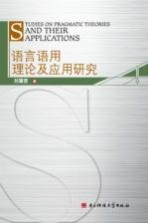图书介绍
语言语用理论及应用研究PDF|Epub|txt|kindle电子书版本网盘下载

- 刘露营著 著
- 出版社: 成都:电子科技大学出版社
- ISBN:9787811149524
- 出版时间:2008
- 标注页数:308页
- 文件大小:10MB
- 文件页数:320页
- 主题词:语用学-对比研究-英语、汉语
PDF下载
下载说明
语言语用理论及应用研究PDF格式电子书版下载
下载的文件为RAR压缩包。需要使用解压软件进行解压得到PDF格式图书。建议使用BT下载工具Free Download Manager进行下载,简称FDM(免费,没有广告,支持多平台)。本站资源全部打包为BT种子。所以需要使用专业的BT下载软件进行下载。如BitComet qBittorrent uTorrent等BT下载工具。迅雷目前由于本站不是热门资源。不推荐使用!后期资源热门了。安装了迅雷也可以迅雷进行下载!
(文件页数 要大于 标注页数,上中下等多册电子书除外)
注意:本站所有压缩包均有解压码: 点击下载压缩包解压工具
图书目录
Chapter One A Study of the Functions of Pragmatic Pre-supposition in Advertising Language1
1.1 Introduction4
1.1.1 Importance of Advertising4
1.1.2 Research Issue and Significance of the Study5
1.1.3 Research Method and Data Source7
1.1.4 Layout and Scope of the Study7
1.2 Literature Review8
1.2.1 Pragmatic Presupposition8
1.2.2 Advertising Language24
1.3 Analysis of the Functions of Pragmatic Presupposition in Advertising Language32
1.3.1 The Research Question32
1.3.2 Data Collection33
1.3.3 Data Analysis34
1.3.4 Results and Discussion78
1.4 Conclusions80
1.4.1 Findings of the Study80
1.4.2 Limitations of the Study80
1.4.3 Suggestions for Further Research81
Chapter Two A Study of Trap-setting in Chinese Debate Tournaments—from the Perspective of Pragma-tic Presupposition83
2.1 Introduction85
2.1.1 Significance of Research on Debate85
2.1.2 Purpose and Significance of the Study86
2.1.3 Layout and Scope of the Study88
2.2 Literature Review89
2.2.1 On Debates89
2.2.2 On Pragmatic Presupposition93
2.2.3 Trap-setting106
2.3 Analysis of Trap-setting with Pragmatic Presuppositions in Chinese Intercollegiate Debate Tournaments108
2.3.1 Research Objectives108
2.3.2 Data Collection109
2.3.3 Data Analysis110
2.3.4 Results and Discussions143
2.4 Conclusions146
2.4.1 Summary of the Study146
2.4.2 Limitations and Suggestions for Further Research147
2.5 Appendix:Excerpts Analyzed in this chapter148
Chapter Three A Pragmatic Analysis of Hedges in Court-room Arguments155
3.1 Introduction157
3.1.1 General Introduction157
3.1.2 Objectives and Significance159
3.1.3 Methodology160
3.1.4 Layout and Scope of the Study160
3.2 Literature Review162
3.2.1 Previous Studies on the Courtroom Arguments162
3.2.2 Previous Studies on Hedges and Hedging166
3.3 Pragmatic Analysis of Hedges in Courtroom Arguments176
3.3.1 Objectives176
3.3.2 Data Collection176
3.3.3 Data Analysis177
3.3.4 Results and Discussion203
3.4 Case Analysis205
3.4.1 Objectives205
3.4.2 Data Collection205
3.4.3 Data Analysis206
3.4.4 Findings and Discussion222
3.5 Conclusions226
3.5.1 Summary of the Study226
3.5.2 Limitations and Suggestions for Further Research227
3.6 Appendix 1 Courtroom arguments in Chinese228
3.7 Appendix 2 Courtroom arguments in English232
3.8 Appendix 3 List of the Arguments235
Chapter Four A Study of the Rhetoric in English Com-munication—From the Perspective of the Violation of Cooperative Principle237
4.1 Introduction238
4.2 Literature Review240
4.2.1 Grice's CP Theory240
4.2.2 Rhetoric241
4.2.3 Previous Studies on CP and Rhetoric242
4.3 Analysis on the Rhetoric through the Violation of CP245
4.3.1 Rhetorie through the Violation of the Maxim of Quantity245
4.3.2 Rhetoric through the Violation of the Maxim of Quality246
4.3.3 Rhetoric through the Violation of the Maxim of Relevance249
4.3.4 Rhetoric through the Violation of the Maxim of Manner250
4.3.5 Findings and Discussion252
4.4 Conclusions253
Chapter Five A Contrastive Study on Politeness Formu-lae in English and Chinese255
5.1 Introduction256
5.1.1 Purpose of the Study256
5.1.2 Significance of the Study256
5.2 Politeness Principle(PP)257
5.2.1 Leech's PP257
5.2.2 Gu's Four Notions on Politeness in China258
5.2.3 Contrastive Overview259
5.2.4 Previous Studies on PP260
5.3 Contrastive Analysis on Politeness Formulae in English and Chinese261
5.3.1 Contrastive Analysis on Addresses in English and Chinese261
5.3.2 Contrastive Analysis on Making Requests and Complimenting in English and Chinese264
5.3.3 Contrastive Analysis on Expressing Thanks and Apologies in English and Chinese267
5.3.4 Findings and Discussion269
5.4 Conclusion270
Chapter Six Study on the Correlation Between Pragma-tic Competence and English Leaming Motivation of Undergraduates272
6.1 Introduction273
6.2 Theoretical Basis274
6.2.1 Pragmatic competence274
6.2.2 Motivation277
6.3 Study on the Correlation Between Pragmatic Competence and Motivation279
6.3.1 Research questions279
6.3.2 Subjects279
6.3.3 Research methods280
6.3.4 Study on undergraduates' pragmatic competence280
6.3.5 Study on undergraduates' motivation282
6.3.6 The correlation between pragmatic competence and motivation284
6.4 Fostering Students' Pragmatic Competence286
6.4.1 The significance of culture instruction to ELT286
6.4.2 The enlightenment in ELT in higher education287
6.5 Conclusion288
Appendix 1:Pragmatic Competence Questionnaire289
Appendix 2:Motivation Questionnaire292
参考书目294